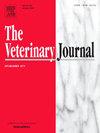马来西亚新发结节性皮肤病病毒的基因组分析和时空分布确定了跨界传播的重组菌株
IF 3.1
2区 农林科学
Q1 VETERINARY SCIENCES
引用次数: 0
摘要
肿块性皮肤病是一种影响牛种的跨界病毒性疾病。在2021年5月之前,马来西亚从未记录过这种疾病,并且到同年12月已传播到马来西亚半岛92个县中的65个县。在这项研究中,我们对从第一波暴发中分离出来的肿块性皮肤病病毒进行了全基因组测序、系统发育分析和地理定位,以更好地了解该病毒的起源、传播和遗传多样性。分离株的全基因组序列保存在GenBank中,登录号为PP145891和PP145892。马来西亚LSDV分离株与来自中国、越南、泰国和印度尼西亚的重组菌株聚集在分支2.5,特别是分支2.5.1。这一疾病在马来西亚的传播与来自泰国的跨界牲畜流动密切相关,这一点从疫情的时空分布可以看出。这项研究强调需要进行持续的基因组监测,以发现新出现的变异,并为有针对性的控制战略提供信息,包括疫苗接种和跨境合作,以遏制未来的疫情。本文章由计算机程序翻译,如有差异,请以英文原文为准。
Genomic analysis and spatiotemporal distribution of newly emerging lumpy skin disease virus in malaysia identify recombinant strain from transboundary spread
Lumpy skin disease is a transboundary viral disease affecting bovine species. This disease had never been recorded in Malaysia prior to May of 2021, and had spread to 65 of 92 districts in Peninsular Malaysia by December of the same year. In this study, we conducted a whole-genome sequencing, phylogenetic analysis and geographical mapping of the outbreak from lumpy skin disease virus isolated from the first wave of outbreaks to better understand the origin, transmission, and genetic diversity of the virus. The whole genome sequences of these isolates were deposited in GenBank with accession number PP145891 and PP145892. Malaysia LSDV isolates were found clustered with recombinant strains in clade 2.5, particularly subclade 2.5.1, which included strains from China, Vietnam, Thailand, and Indonesia. The spread of the disease in Malaysia was closely linked to cross-border cattle movements from Thailand, as evidenced by the spatiotemporal distribution of the outbreaks. This study emphasizes the need for ongoing genomic surveillance to detect emerging variants and inform targeted control strategies, including vaccination and cross-border cooperation to curb future outbreaks.
求助全文
通过发布文献求助,成功后即可免费获取论文全文。
去求助
来源期刊

Veterinary journal
农林科学-兽医学
CiteScore
4.10
自引率
4.50%
发文量
79
审稿时长
40 days
期刊介绍:
The Veterinary Journal (established 1875) publishes worldwide contributions on all aspects of veterinary science and its related subjects. It provides regular book reviews and a short communications section. The journal regularly commissions topical reviews and commentaries on features of major importance. Research areas include infectious diseases, applied biochemistry, parasitology, endocrinology, microbiology, immunology, pathology, pharmacology, physiology, molecular biology, immunogenetics, surgery, ophthalmology, dermatology and oncology.
 求助内容:
求助内容: 应助结果提醒方式:
应助结果提醒方式:


